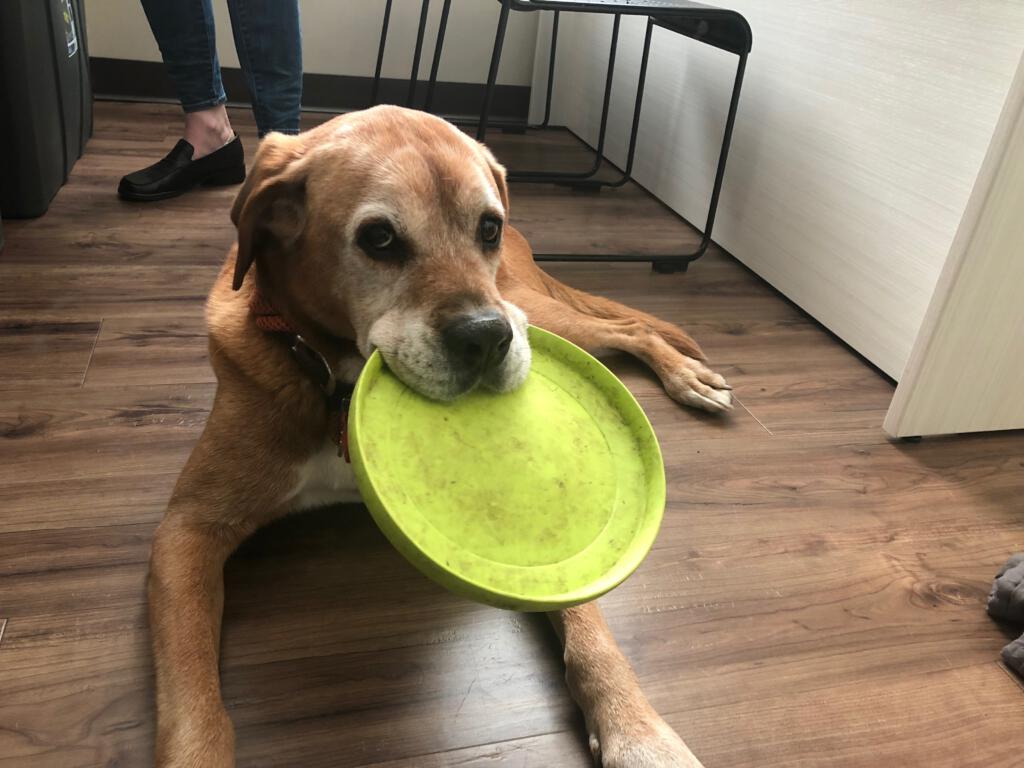Mobility in Older Dogs

As promised in our previous post on living with geriatric pets, this is a look at modifying the environment for the aging dog and making sure they aren’t in pain. Pets that are in pain don’t get as much exercise as they would otherwise, and as with people are more likely to have other health issues including weight gain, skin problems, urinary tract infections, and muscle wasting. In other words, pain contributes to the overall frailty associated with old age. Pain can also hinder efforts to have a full bowel movement; a painful pet may defecate only enough to relieve the pressure in the colon but not enough to fully empty their bowels. As they sleep, the sphincter relaxes and then when they get up, the abdominal pressure/relaxed sphincter combination can result in fecal incontinence.
Diagnosis
If you’ve noticed a change in behaviour in your dog, is it “something” or is he/she “just getting old”? More often than not, it really is something. In fact, pets are notoriously good at hiding their pain and illness. They can compensate for mild deficits or issues, hiding them right up until the time that they cannot – at which point the deficits are “unmasked” and show up “suddenly”. However, we must be careful not to just chase the new unmasked pain/limited mobility/neurological deficits but to also rule out concurrent disease processes. As with all medicine, this requires a thorough physical exam, and getting the full history from the family, looking carefully at any gradual or sudden changes in appetite, mobility and other daily habits. The next step usually involves lab work, radiographs, and ultrasound as needed. In a lame patient or one that is less mobile than before, it is important to rule out other possible underlying issues even if arthritis is suspected or has been previously diagnosed.
Signs

What might suggest your older dog is in pain? Signs of pain from arthritis include:
- difficulty on rising
- occasional yelp when moving
- no longer wanting to go on long walks or go up stairs
- reluctance to jump up (into the car, or onto the couch/bed)
How to help your ouchy arthritic older dog
Modifying your pet’s environment is a big part of helping them manage their challenges. These modifications can include:
- surfaces with good traction to permit good footing for rising and walking without the pet’s feet slipping out to the side; if all the floors are hard surfaces, provide non-slip mats in the pet’s area
- minimize the need to jump by providing a ramp for the car, and stairs or long stool for getting up onto furniture (whether they are allowed on furniture is a discussion for another time)
- maintain muscle mass with walks and physiotherapy. Swimming can be good non-weightbearing exercise, but be careful your pet doesn’t overdo it.

Medications can help with both pain and inflammation, and as in human medicine, the options continue to improve and increase, but are not without risk.
- NSAIDs. These drugs, in particular, have a very narrow “therapeutic margin” in animals. That means that the difference between a helpful/safe dose and a toxic dose is small. These drugs are in the same family as aspirin/ibuprofen and are a mainstay of arthritis treatment in dogs and humans. These medications also can cause kidney injury and ulceration of the stomach and intestines. Ibuprofen is toxic in dogs and aspirin has too broad a range of side effects (vets may use a very low dose for clotting problems); luckily, veterinarians have access to newer types of NSAID specifically designed for pets. Metacam and Deramaxx may be the most commonly prescribed ones but there are others, and there are promising newcomers on the market. While meloxicam (Metacam) is also available as a medicine for humans as well, it comes in the human dosage. While this might seem economical for larger pets, again, the medication is safer with very precise dosage. We don’t recommend the medication meant for humans (meloxicam) but if it is going to be used, make sure you consult with your veterinarian for the exact dose. The digestive tract doesn’t always tolerate medications well, so it’s very important (especially in older patients) to pay close attention to your pet’s appetite if they are on NSAIDs. Signs of ulcers can be subtle and you don’t want to wait until your dog no longer eats or is vomiting. Most owners won’t miss something dramatic like blood in the stool (which looks black and tarry) or vomiting blood, but the less dramatic signs of nausea include licking their lips, not wanting to eat, and vomiting. Very subtle changes, such as taking more time to eat their meals or eating with less enthusiasm, are significant. If you notice any of these signs, stop the medication and see your veterinarian. Some patients may benefit from a concurrent antacid while on NSAIDs.
- Acetaminophen (Tylenol – in a different category from NSAIDs). The dosage of acetaminophen is also narrow in dogs, but your veterinarian can discuss a safe dose, which is lower than the dose for humans; it can be formulated especially for smaller breeds. It can be given up to twice a day. This might be a good alternative if your pet has a sensitive stomach. A reminder for cat owners – Tylenol is deadly for cats!
Other medications are available if the above medications are not tolerated well, or inadequate. However, the possible benefit of these needs to be weighed against older pets having to take yet more pills, especially when they already may have a poor appetite and upset stomach. These medications may include:
- Tramadol, a mild opioid medication, can also be prescribed. It has side effects typical of narcotics (upset stomach, vomiting, constipation, and sleepiness) and while it may help with discomfort, some research indicates that dogs don’t metabolize tramadol the same way humans do so that the actual pain relief may be less and may not last very long.
- Gabapentin treats neuropathic pain (nerve pain). It may make your dog sleepy for the first few days but this usually goes away. While it is mostly used in humans and dogs for nerve pain, some veterinarians will add it to the regime, or consider it if other medications are not well tolerated.
- Supplements such as glucosamine and chondroitin that are thought to possibly help protect and lubricate existing cartilage may be included in your elderly pet’s medication regime.
- CBD oil – unknown efficacy and safety, yet increasing in popularity; see our recent blog post.
Aging is inevitable for dogs just as it is for us, but taking the time to carefully observe your dog’s behaviour and making adjustments as their needs require will help them to make the most of their “golden years”.

